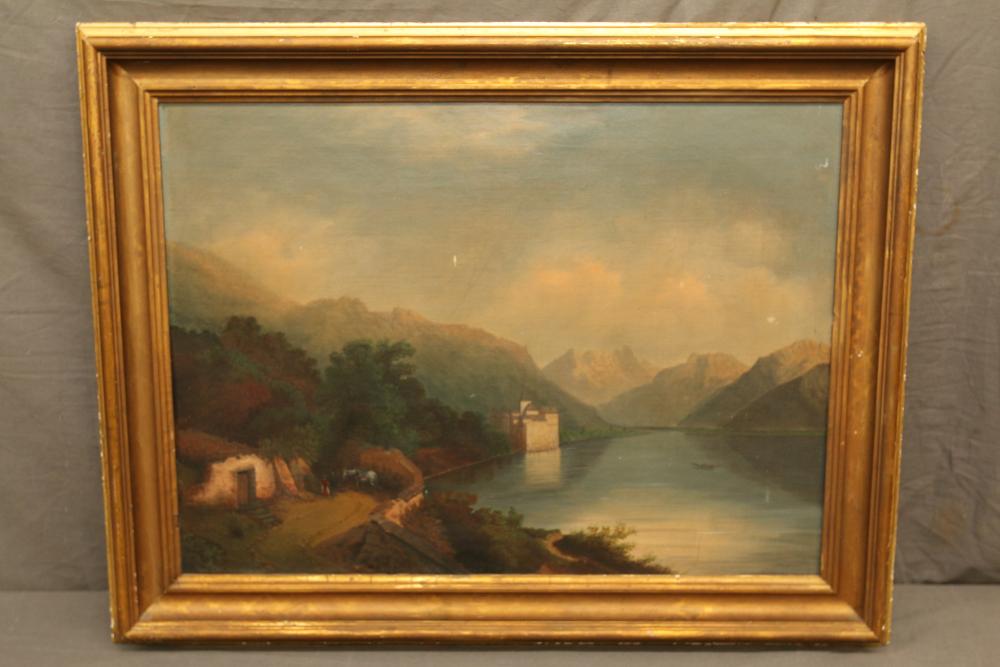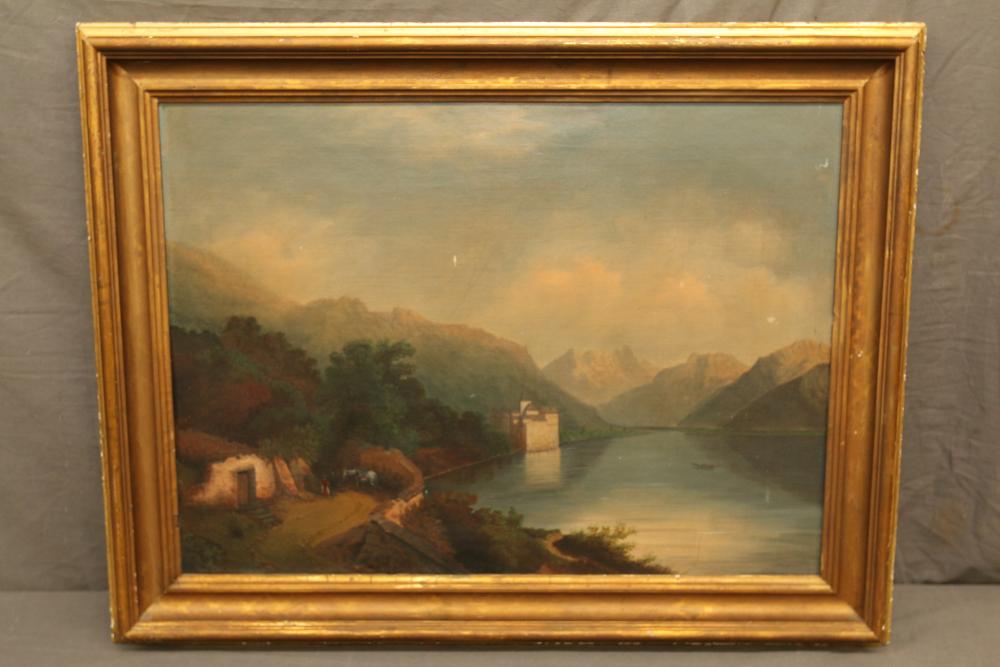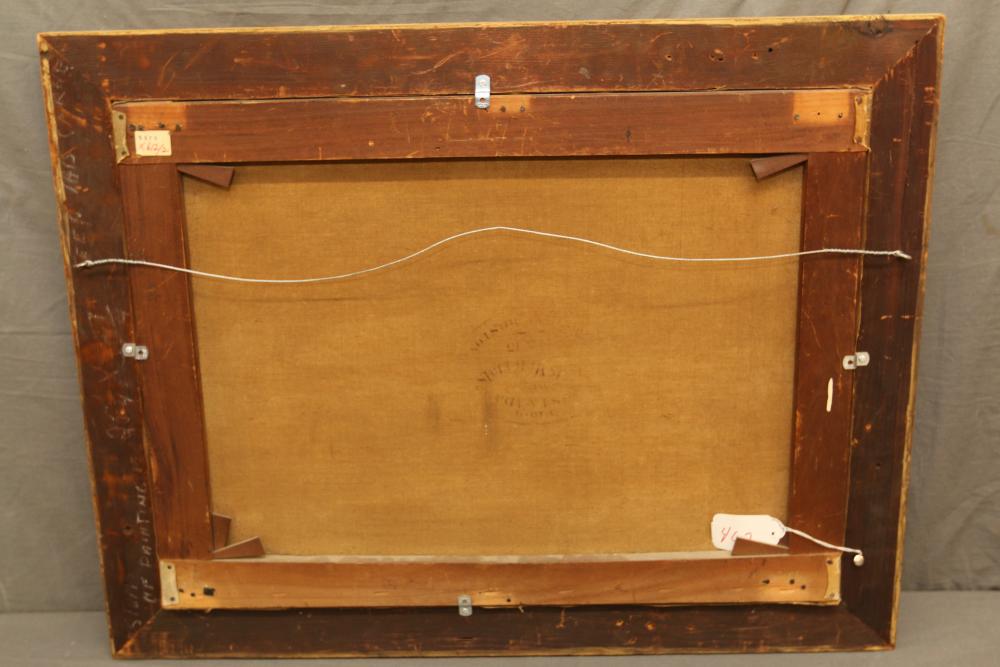Auctioneer's Note: The first American School of Art is known as ''The Hudson River School,'' consisting of mid-nineteenth century ''Nature Painters'' who found spirituality in nature. These adventuresome artists hiked to see impressive views. They sketched and did studies in the field to bring back to their studios where they would create the finished paintings. The Hudson River served as the main route of travel to the best places, as well as provided the best subject matter. New York City, with the National Academy of Design to exhibit at, was the center of the American Arts world in the 19thC. Now you can bid on 69 lots of paintings and prints, mostly related to the Hudson Valley. Today, with an emphasis on conservation of resources, and going ''Green,''it is the best time to purchase and enjoy these beautiful works. Bidding is online, with the opportunity to preview at the Absolute Auction Center. Every lot starts at $1.00 and sells to the highest bidder. Good luck! - Rob Doyle. Items located in Pleasant Valley, NY.
Payment is due by Thursday, February 27 at 1PM.
Pickup in Pleasant Valley, NY must be completed by Thursday, February 27 at 3PM.
All lots sold as is, where is. There is a 15% Buyers Premium for all lots purchased. Payment methods for non-vehicles & non-equipment include cash, MC, Visa, Discover or good check. Payment method for vehicles & equipment is cash, cashiers check, money order or wire transfer only, no exceptions. You can make credit card payment online by going to "My Account" and selecting your invoice.
Preview available Monday-Friday 9am-3pm by appointment only or online 24 hours. Use this link to get directions to the Absolute Auction Center: http://mapq.st/1wgg9jz
** NOTE: Shipping is available on all items with proper identification.**
Click More Info/Bid Now for additional photos.
Payment is due by Thursday, February 27 at 1PM.
Pickup in Pleasant Valley, NY must be completed by Thursday, February 27 at 3PM.
All lots sold as is, where is. There is a 15% Buyers Premium for all lots purchased. Payment methods for non-vehicles & non-equipment include cash, MC, Visa, Discover or good check. Payment method for vehicles & equipment is cash, cashiers check, money order or wire transfer only, no exceptions. You can make credit card payment online by going to "My Account" and selecting your invoice.
Preview available Monday-Friday 9am-3pm by appointment only or online 24 hours. Use this link to get directions to the Absolute Auction Center: http://mapq.st/1wgg9jz
** NOTE: Shipping is available on all items with proper identification.**
Click More Info/Bid Now for additional photos.
Auction Info
Auctioneer's Note: The first American School of Art is known as ''The Hudson River School,'' consisting of mid-nineteenth century ''Nature Painters'' who found spirituality in nature. These adventuresome artists hiked to see impressive views. They sketched and did studies in the field to bring back to their studios where they would create the finished paintings. The Hudson River served as the main route of travel to the best places, as well as provided the best subject matter. New York City, with the National Academy of Design to exhibit at, was the center of the American Arts world in the 19thC. Now you can bid on 69 lots of paintings and prints, mostly related to the Hudson Valley. Today, with an emphasis on conservation of resources, and going ''Green,''it is the best time to purchase and enjoy these beautiful works. Bidding is online, with the opportunity to preview at the Absolute Auction Center. Every lot starts at $1.00 and sells to the highest bidder. Good luck! - Rob Doyle. Items located in Pleasant Valley, NY.
Payment is due by Thursday, February 27 at 1PM.
Pickup in Pleasant Valley, NY must be completed by Thursday, February 27 at 3PM.
All lots sold as is, where is. There is a 15% Buyers Premium for all lots purchased. Payment methods for non-vehicles & non-equipment include cash, MC, Visa, Discover or good check. Payment method for vehicles & equipment is cash, cashiers check, money order or wire transfer only, no exceptions. You can make credit card payment online by going to "My Account" and selecting your invoice.
Preview available Monday-Friday 9am-3pm by appointment only or online 24 hours. Use this link to get directions to the Absolute Auction Center: http://mapq.st/1wgg9jz
** NOTE: Shipping is available on all items with proper identification.**
Click More Info/Bid Now for additional photos.
Payment is due by Thursday, February 27 at 1PM.
Pickup in Pleasant Valley, NY must be completed by Thursday, February 27 at 3PM.
All lots sold as is, where is. There is a 15% Buyers Premium for all lots purchased. Payment methods for non-vehicles & non-equipment include cash, MC, Visa, Discover or good check. Payment method for vehicles & equipment is cash, cashiers check, money order or wire transfer only, no exceptions. You can make credit card payment online by going to "My Account" and selecting your invoice.
Preview available Monday-Friday 9am-3pm by appointment only or online 24 hours. Use this link to get directions to the Absolute Auction Center: http://mapq.st/1wgg9jz
** NOTE: Shipping is available on all items with proper identification.**
Click More Info/Bid Now for additional photos.
Categories:
Wikipedia: Chillon began as a Roman outpost, guarding the strategic road through the Alpine passes.[2] The later history of Chillon was influenced by three major periods: the Savoy Period, the Bernese Period, and the Vaudois Period.[3] Savoy period Edit Arms of the House of Savoy The oldest parts of the castle have not been definitively dated, but the first written record of the castle is in 1005.[4] It was built to control the road from Burgundy to the Great Saint Bernard Pass[5] From the mid 12th century, the castle was summer home to the Counts of Savoy, who kept a fleet of ships on Lake Geneva. The castle was greatly expanded in 1248[6] by Peter II.[7] Chillon as a prison Edit During the 16th century Wars of Religion, it was used by the dukes of Savoy to house prisoners. Its most famous prisoner was probably François de Bonivard, a Genevois monk, prior of St. Victor in Geneva and politician who was imprisoned there in 1530 for defending his homeland from the dukes of Savoy.[8] Bernese period Edit Over his six-year term, de Bonivard paced as far as his chain would allow, and the chain and rut are still visible. He was rescued in 1536 by his countrymen and Bernese, who took the castle by force. The prison was residence for Bernese bailiff until Chillon was converted into a state prison in 1733.[9] Vaudois period Edit In 1798, the French-speaking canton of Vaud drove out the German-speaking Bernese authorities and declared the Lemanic Republic. The Vaudois invited in French troops to help them maintain autonomy from the other Swiss. When the French moved in and occupied, Chillon was used as a munitions and weapons depot.[10] Today Edit Today, Chillon is currently open to the public for visits and tours. According to the castle website, Chillon is listed as "Switzerland's most visited historic monument".[11] There is a fee for entrance and there are both parking spaces and a bus stop nearby for travel. Inside the castle there are several recreations of the interiors of some of the main rooms including the grand bedroom, hall, and cave stores. Inside the castle itself there are four great halls, three courtyards, and a series of bedrooms open to the public. One of the oldest is the Camera domini, which was a room occupied by the Duke of Savoy-it is decorated with 14th Century medieval murals.
More Details
Wikipedia: Chillon began as a Roman outpost, guarding the strategic road through the Alpine passes.[2] The later history of Chillon was influenced by three major periods: the Savoy Period, the Bernese Period, and the Vaudois Period.[3] Savoy period Edit Arms of the House of Savoy The oldest parts of the castle have not been definitively dated, but the first written record of the castle is in 1005.[4] It was built to control the road from Burgundy to the Great Saint Bernard Pass[5] From the mid 12th century, the castle was summer home to the Counts of Savoy, who kept a fleet of ships on Lake Geneva. The castle was greatly expanded in 1248[6] by Peter II.[7] Chillon as a prison Edit During the 16th century Wars of Religion, it was used by the dukes of Savoy to house prisoners. Its most famous prisoner was probably François de Bonivard, a Genevois monk, prior of St. Victor in Geneva and politician who was imprisoned there in 1530 for defending his homeland from the dukes of Savoy.[8] Bernese period Edit Over his six-year term, de Bonivard paced as far as his chain would allow, and the chain and rut are still visible. He was rescued in 1536 by his countrymen and Bernese, who took the castle by force. The prison was residence for Bernese bailiff until Chillon was converted into a state prison in 1733.[9] Vaudois period Edit In 1798, the French-speaking canton of Vaud drove out the German-speaking Bernese authorities and declared the Lemanic Republic. The Vaudois invited in French troops to help them maintain autonomy from the other Swiss. When the French moved in and occupied, Chillon was used as a munitions and weapons depot.[10] Today Edit Today, Chillon is currently open to the public for visits and tours. According to the castle website, Chillon is listed as "Switzerland's most visited historic monument".[11] There is a fee for entrance and there are both parking spaces and a bus stop nearby for travel. Inside the castle there are several recreations of the interiors of some of the main rooms including the grand bedroom, hall, and cave stores. Inside the castle itself there are four great halls, three courtyards, and a series of bedrooms open to the public. One of the oldest is the Camera domini, which was a room occupied by the Duke of Savoy-it is decorated with 14th Century medieval murals.
High Bid:
$250.00 – rzr
Auction Type: One Lot
Quantity: 1
Bidding has closed on this lot













